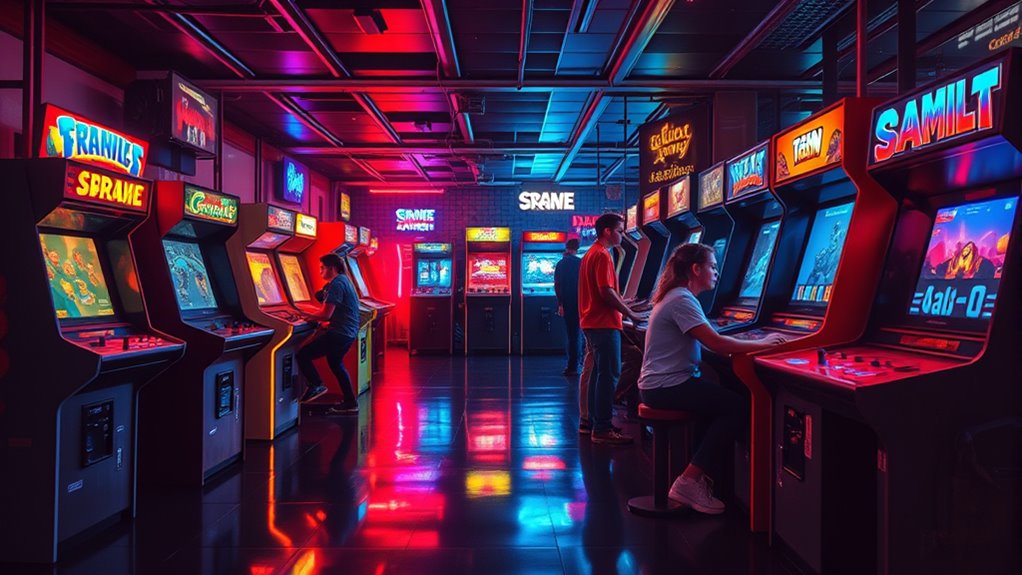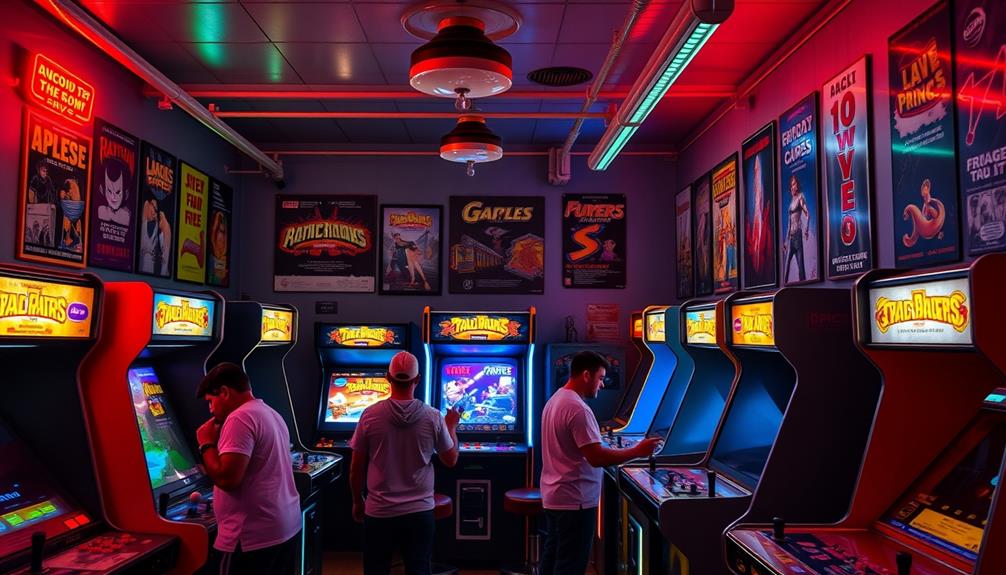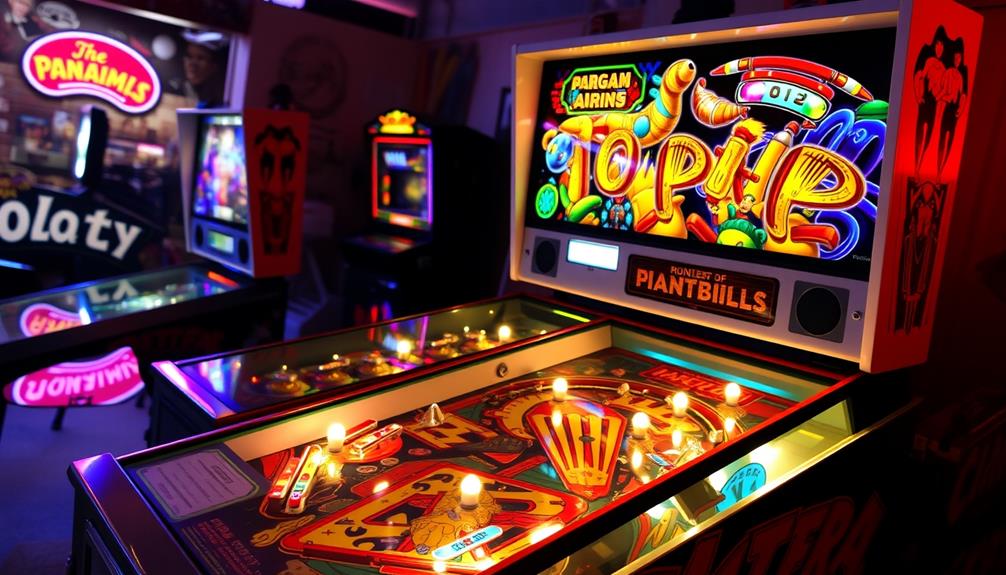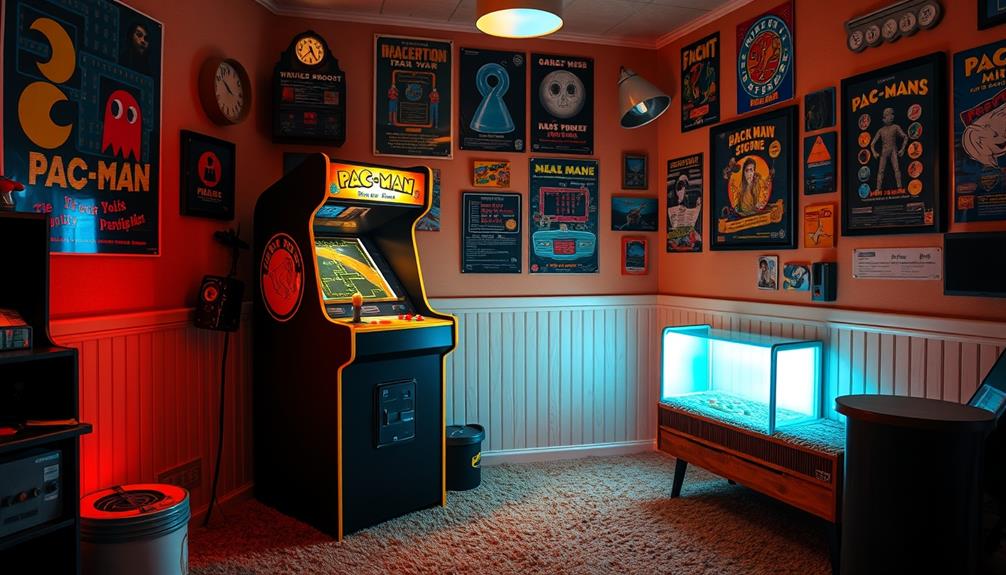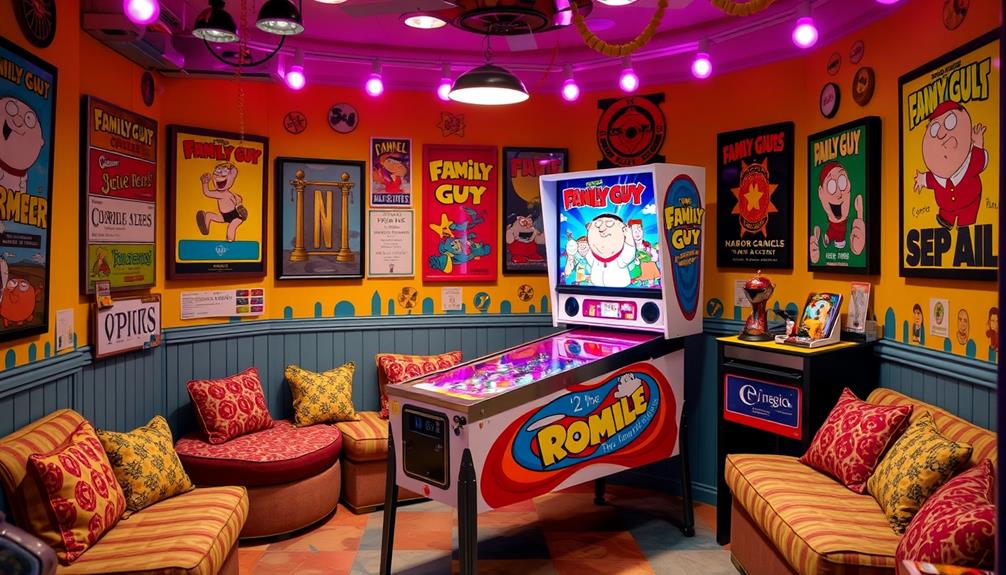The birth of the Golden Age of Arcade Games happened in the late 1970s and early 1980s when technological advances made games more immersive, vibrant, and exciting. Pioneering developers created iconic titles like Pac-Man and Donkey Kong, which drew crowds and became cultural phenomena. Arcades became lively social hubs where players competed and shared experiences, shaping modern gaming. To explore how these innovations and cultural shifts transformed entertainment, keep exploring this fascinating era.
Key Takeaways
- The Golden Age of Arcade Games began in the late 1970s with iconic titles like Pac-Man and Donkey Kong.
- Hardware advancements enabled more immersive graphics, sound, and durable arcade machines, fueling widespread popularity.
- Developers focused on character design, sound effects, and gameplay innovation to attract and engage players.
- Arcades became social hubs, fostering community, competition, and cultural influence through music, fashion, and media.
- The era laid the foundation for modern gaming, influencing game design, eSports, and pop culture to this day.
The Rise of Arcade Technology and Innovation
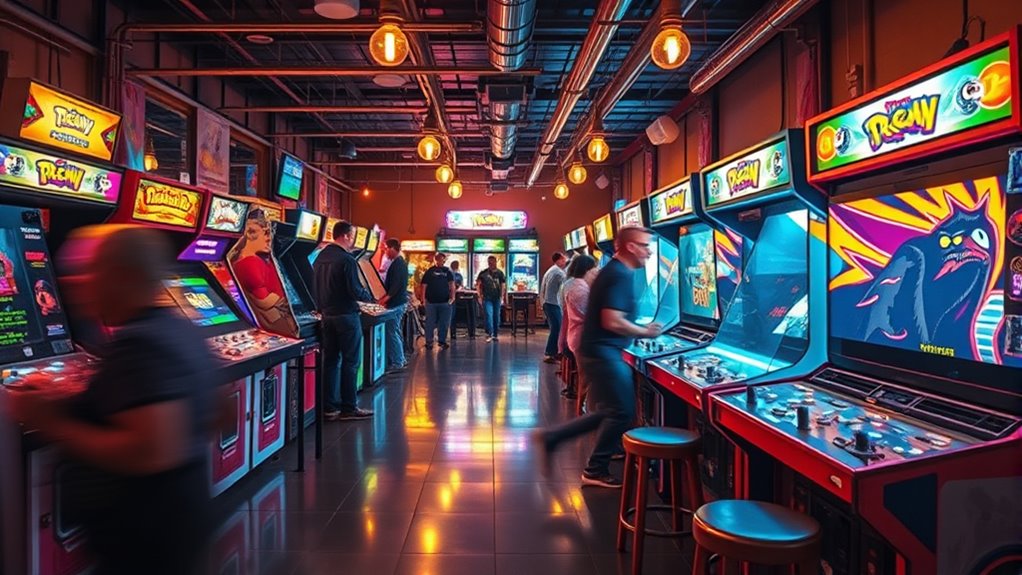
The rise of arcade technology and innovation transformed the gaming landscape by making electronic entertainment more accessible and exciting. Hardware advancements played a vital role, allowing arcade machines to deliver sharper graphics, faster processing, and more durable components. These improvements meant games ran smoother and lasted longer, attracting more players. Joystick innovations also changed how you interacted with games, offering more precise control and a better gaming experience. Early joysticks evolved from simple switches to sophisticated devices that responded quickly to your movements. This progress in hardware and control methods made arcade games more immersive and engaging. Additionally, Kia Tuning developments in hardware and control systems inspired improvements in gaming peripherals, making the experience even more dynamic. As a result, arcades became vibrant social hubs, drawing crowds enthusiastic to test new technology and experience the thrill of cutting-edge gaming.
Pioneering Game Developers and Their Creations

Pioneering game developers harnessed innovation and creativity to shape the golden age of arcade games. They focused on character design to make each game memorable, giving players iconic figures to root for or challenge. Sound engineering also played a vital role, adding immersive audio effects that enhanced gameplay and heightened excitement. Developers experimented with visual styles and audio cues to create a mesmerizing experience, setting their games apart from earlier experiments. Titles like Pac-Man and Donkey Kong showcased distinctive characters and catchy sounds, defining the era’s aesthetic. These creators pushed technological limits, blending artistic vision with engineering skill. Their work laid the foundation for modern game design, proving that engaging characters and compelling sound could transform simple concepts into arcade legends.
The Cultural Impact of Arcade Gaming
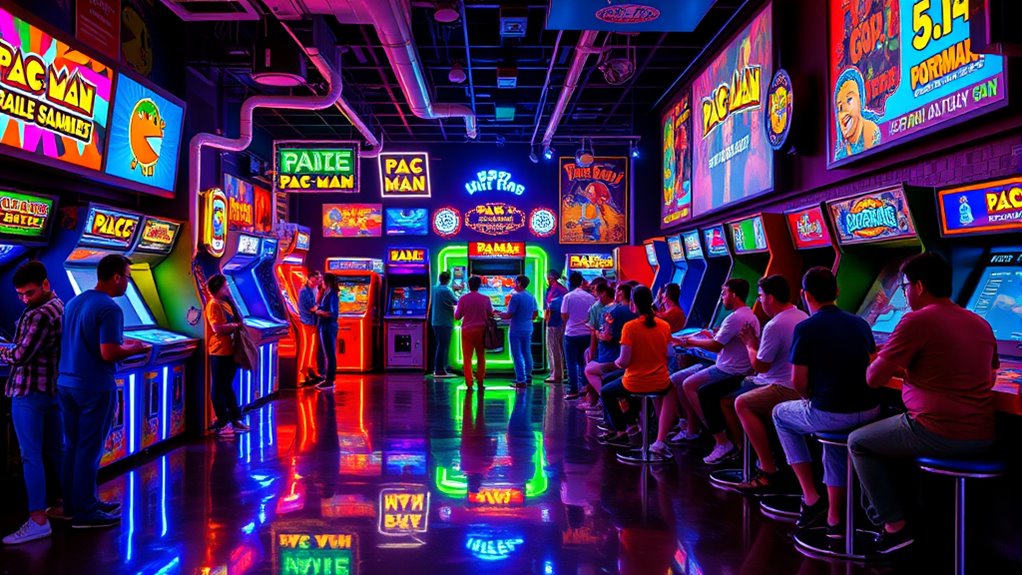
Arcade gaming changed how people connect and compete in public spaces, creating new social dynamics. These games also became a staple of pop culture, inspiring movies, music, and fashion. As you explore this era, you’ll see how arcades shaped both social interactions and cultural trends. Additionally, the rise of juice cleanses and detox during this period reflected a growing interest in health and wellness trends.
Social Interaction Dynamics
As arcade games gained popularity, they transformed public spaces into vibrant social hubs where players gathered, competed, and shared experiences. Player engagement soared as people cheered each other on and celebrated victories. Multiplayer dynamics fostered a sense of community, turning solitary play into collective fun. You’ll notice that these interactions created lasting bonds and friendly rivalries, making arcades more than just gaming spots—they became social centers. Additionally, the introduction of eye patch benefits in gaming environments, such as themed accessories or promotional items, subtly enhanced the immersive experience for players.
Pop Culture Integration
The lively social scene surrounding arcade games didn’t just foster friendships; it also propelled these games into the broader cultural spotlight. Music influence played a significant role, as iconic arcade sounds and catchy tunes became part of popular culture, inspiring dance moves and even music genres. Arcade-themed music tracks found their way into mainstream media, amplifying their reach. Additionally, the emergence of support hours for arcade facilities helped sustain the vibrant community by ensuring players could enjoy their favorite games consistently. Simultaneously, fashion trends emerged, with players sporting graphic t-shirts, high-top sneakers, and accessories inspired by game characters and arcade logos. These styles reflected the vibrant energy of the arcade scene, making gaming culture visible in everyday life. By blending music and fashion, arcade gaming left an indelible mark on pop culture, shaping trends that extended far beyond the arcade halls.
Iconic Titles That Defined an Era
Several titles stand out as defining moments in the golden age of arcade games, shaping the industry and capturing players’ imaginations. These games evoke nostalgic memories and showcase iconic arcade aesthetics that defined the era.
A new sentence with dynamic communication exercises and the rest of the sentence.
The Social Scene of Arcades in the 1980s

Arcades in the 1980s weren’t just places to play games; they were vibrant social hubs where friendships formed, rivalries ignited, and communities gathered. You quickly learned the importance of arcade etiquette—taking turns, respecting others’ gameplay, and avoiding disruptive behavior. These rules kept the environment friendly and welcoming. Gaming camaraderie thrived as players cheered each other on, shared tips, and celebrated victories together. You found camaraderie in the shared excitement of high scores and challenging opponents, often bonding over late-night sessions. The arcade was more than just a space for individual play; it was a social scene where community spirit flourished, and everyone contributed to the lively, energetic atmosphere that made the 1980s arcade scene unforgettable. Additionally, the competitive edge of arcade gaming often pushed players to improve their skills and high refresh rates to stay ahead of the game.
Legacy and Influence on Modern Gaming

The innovations from arcade games set the stage for today’s gaming technology, influencing everything from graphics to gameplay. These early titles also left a lasting cultural mark, shaping how we view gaming as entertainment. Understanding this legacy helps you appreciate how modern games continue to evolve from those pioneering days. Recognizing the role of expert reviews and user voting in curating top-tier recommendations further highlights the importance of quality and trusted sources in discovering the best gaming experiences.
Technological Innovations Persist
Technological innovations from the golden age of arcade games continue to shape modern gaming in profound ways. The hardware evolution sparked by arcade pioneers laid the foundation for today’s gaming consoles and PCs. These advancements improved graphics, processing power, and input devices, influencing how games are developed and played. You can see this in the refinement of gameplay mechanics, which became more complex and engaging. Moreover, the development of high-performance ratings and smart technology integration in arcade systems contributed to the reliability and efficiency found in modern gaming hardware. 1. Modern controllers and VR headsets trace back to arcade joysticks and buttons, enhancing user interaction. 2. Graphics technology evolved from pixelated sprites to high-definition visuals, thanks to early hardware breakthroughs. 3. Gameplay mechanics like scoring systems and multi-level design originated in arcade games, now integral to modern titles.
Cultural Impact Endures
Born from the innovations of the golden age, arcade games have left an enduring mark on modern gaming culture. You can still feel the thrill of arcade nostalgia during retro game nights or when spotting classic cabinets. These games influenced contemporary titles, blending simple mechanics with competitive spirit. Their cultural impact endures through memes, collectibles, and dedicated communities that cherish nostalgic memories. Whether through eSports or indie recreations, the legacy persists. To see this influence, consider the following:
| Aspect | Example |
|---|---|
| Cultural Significance | Inspired modern game design |
| Nostalgic Memories | Revisit classic arcade titles |
| Community Impact | Arcade nostalgia events and meetups |
A long-lasting influence of arcade games continues to shape the gaming landscape today.
Frequently Asked Questions
How Did Arcade Gaming Influence Home Console Development?
You might not realize it, but arcade gaming had a huge impact on home console development. In fact, the 1980s saw over 15,000 arcade cabinets worldwide, showcasing vibrant arcade aesthetics and coin-operated mechanics that players loved. These designs and gameplay styles influenced console creators, who aimed to replicate that immersive experience at home. Arcade innovation pushed developers to improve graphics, controls, and game complexity, shaping the evolution of home gaming forever.
What Were the Biggest Challenges Faced by Early Arcade Developers?
You face significant challenges as an early arcade developer, especially with hardware limitations that restrict game complexity and graphics. Economic challenges also pose hurdles since developing and maintaining arcade machines costs money, and attracting players is vital for revenue. You have to balance limited technology with budget constraints, often innovating creatively to make engaging, reliable games that stand out and attract players in a competitive market.
How Did Arcade Culture Vary Across Different Countries?
You notice how arcade culture varies across countries, a dance between cultural differences and regional adaptations. In Japan, arcades blend high-tech games with social spaces, while in the US, they emphasize competitive gameplay and standalone machines. These differences reflect local tastes, values, and technologies, shaping unique gaming experiences worldwide. Despite the similarities in gameplay, each region’s cultural nuances create distinct arcade environments, enriching the global gaming landscape.
What Role Did Marketing Play in Arcade Game Popularity?
You see, marketing played a pivotal role in boosting arcade game popularity through effective arcade branding and promotional strategies. By creating eye-catching arcade machines and memorable logos, developers attracted players. Promotions like tournaments and special events encouraged repeat visits. These efforts made games stand out in crowded arcades, increasing their appeal. Ultimately, your engagement with these marketing tactics helped turn arcade games into cultural phenomena, fueling their golden age.
Are There Any Hidden or Unreleased Arcade Games From That Era?
You wonder if secret prototypes or unreleased classics from that era still exist. Back then, developers often created hidden or abandoned projects, leaving behind mysterious arcade games that never hit the public eye. Some of these secret prototypes remain tucked away in old warehouses or forgotten in digital archives, fueling curiosity among collectors and enthusiasts enthusiastic to uncover lost treasures from the golden age of arcade games.
Conclusion
Now that you’ve explored the birth of the golden age of arcade games, it’s clear how these innovations shaped gaming as we understand it. From pioneering tech to iconic titles, arcades created a vibrant social scene that still influences us today. Can you imagine a world without those early pixelated adventures that sparked your passion? It’s a reminder that every great innovation starts with a simple idea—so what will you create next?
